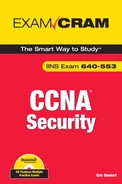|
Fill in the blanks with the best choice from the list. Cryptography is the art of code __________ and cryptanalysis is the art of code __________.
|
||||||||||||||||
|
2. |
Read the following sentence and choose the type of attack that is being described from the list of choices. Several examples of ciphertext created by the same cryptosystem are statistically analyzed to deduce underlying plaintext by pattern analysis.
|
|||||||||||||||
|
3. |
Match the following crypto algorithms with the letter corresponding to its key length.
Your choices are: A. 1 to 256 bits B. 112 and 168 bits C. 56 bits D. 128, 192, and 256 bits E. 32 to 448 bits |
|||||||||||||||
|
4. |
True or false. AES is considered a trusted encryption algorithm by virtue of its strong 128-bit encryption keys and its 20+ years of use in crypto systems. |
|||||||||||||||
|
5. |
What is the best choice of category of encryption algorithm for situations where large volumes of data are transmitted and speed is important? (Choose one from the list.) A. Block cipher B. Stream cipher C. Symmetric key encryption D. Asymmetric key encryption E. DES |
|||||||||||||||
|
6. |
Figure 6.14 illustrates what type of PKI topology? (Choose the one best answer.) A. Subordinate-Tiered CA B. Cross-Certified CA C. Central CA D. Hierarchical CA E. Independent-Mesh CA |
|||||||||||||||
|
7. |
Figure 6.15 illustrates the part of the enrollment process that occurs after a PKI participant has retrieved and validated the CA’s certificate. What is always contained in the PKCS #7 message that the PKI participant is retrieving from the CA? (Choose all the correct answers.) A. X.509 certificate B. CA’s private key C. CA’s public key D. PKI participant’s signed public key E. CA’s encryption usage keys F. None of the above. |
|||||||||||||||
|
8. |
Which of the following list of protocols are part of NIST’s Digital Signature Standard (DSS)? (Choose all that apply.) A. DSA B. Digital Signatures using Reversible Public Key Cryptography C. SEAL D. Blowfish E. ECDSA |
|||||||||||||||
|
9. |
Fill in the blanks in the following sentence with the letter corresponding to the best choice. (Choose three.) Hashing functions are used to validate a message’s __________ but do not provide for __________ like HMACs. If __________ is required, the use of digital signatures is specified. A. Confidentiality B. Integrity C. Authentication D. Non-repudiation E. Origin authentication |
|||||||||||||||
|
10. |
Which one of the following statements best compares MD5 and SHA-1 as hashing algorithms? A. MD5 theoretically has higher security than SHA-1; however, SHA-1 remains more commonly used. B. MD5 is not recommended for new cryptosystems because SHA-1 is preferred for its theoretically higher security. C. SHA-1 is less resistant to a brute force attack than MD5, and its 32-bit longer buffer makes it faster than MD5. D. SHA-1 and MD5’s security is not based on encryption keys. E. None of the above. |


